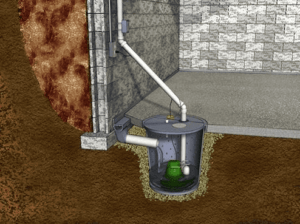As a homeowner, protecting your property from water damage is a top priority. Especially, if you live in an area prone to flooding or have a basement susceptible to water seepage. This is where a sump pump becomes a key tool in protecting your home and valuables. In this guide, we will cover the basics of sump pump. More specifically, their function, and why they are important for homes in flood-prone areas or with basement water issues.
What is a Sump Pump?
A sump pump is a mechanical device designed to remove excess water from the lowest point of your home. This is commonly found in the basement or crawl space. It consists of a pump, typically placed inside a sump pit or basin; and a float switch that activates the pump when the water level rises above a certain point. When water enters the pit, the float rises. It triggers the pump to turn on and discharge the water away from your home’s foundation through a discharge pipe.

How Does a Sump Pump Work?
Sump pumps work on a simple principle of physics. When water accumulates in the sump pit, the float switch rises with the water level. Once the float reaches a predetermined height, it triggers the pump to activate. The pump then uses its impeller. This is a rotating component, to force the water out of the pit through the discharge pipe and away from the building. This continuous process helps keep the water level around your home’s foundation low. It prevents flooding and water damage.
Types of Sump Pumps: Submersible and Pedestal
There are two primary types of sump pumps commonly used in residential applications: submersible and pedestal.
Submersible Sump Pumps: These pumps are designed to be submerged in the sump pit. This option is more discreet and less prone to mechanical damage. Submersible pumps are preferred for their quiet operation and efficiency. Because they are installed inside the pit, they are not visible. Which is aesthetically appealing to many homeowners.
Pedestal Sump Pumps: Unlike submersible pumps, pedestal pumps have the motor placed above the sump pit, with only the impeller submerged. These pumps are easier to access and maintain, as the motor is not in contact with water. However, they tend to be noisier and may have a shorter lifespan compared to submersible pumps.
Why Are Sump Pumps Important for Homes in Flood-Prone Areas?
Homes located in flood-prone areas are at a higher risk of water intrusion during heavy rainfall, storms, or rapid snowmelt. A sump pump is a valuable defense against these natural forces. By quickly removing water that seeps into the sump pit, it prevents it from accumulating and flooding your basement or lower levels. A properly functioning sump pump can make a significant difference in minimising potential water damage and saving you from costly repairs.
Basement Water Issues and Sump Pumps: A Perfect Match
Even if your home is not situated in a flood-prone region, basement water issues can still be a common concern. Basements are naturally more vulnerable to water seepage due to their location below ground level. Moisture can enter through cracks in the foundation, faulty drainage systems, or during heavy rains. This excess moisture not only poses a threat to your belongings and the structural integrity of your home but can also create an environment conducive to mould and mildew growth.
A sump pump acts as a reliable line of defence against these basement water issues. By quickly removing excess water, it helps maintain a dry and habitable space in your basement. It reduces the risk of water damage and potential health hazards associated with mould growth.
Speaking of protecting your home from water-related issues, it’s important to address any potential water leaks right away. If you ever notice signs of water damage, such as damp spots on walls or ceilings, musty odours, or unexplained increases in water bills, reach out to us immediately. Our expertise in water leak detection and repair can help prevent further damage and make sure your home remains dry and well-maintained. Remember, proactive maintenance is key to a secure and comfortable living space.
The Importance of Sump Pump Maintenance
To make sure your sump pump operates effectively when needed, regular maintenance is the key here. Over time, debris and sediment can accumulate in the sump pit. Thus, potentially clogging the pump or affecting its float switch. It is important to inspect and clean the pump and pit at least once a year. Especially before the rainy season or periods of increased water activity.
Additionally, testing your sump pump periodically is important. Pour water into the pit to simulate rising water levels and observe if the pump activates as it should. If you have a battery backup system, verify that it functions correctly to keep your pump operational during power outages.
In short, a sump pump plays a major role in protecting your home from water damage. Particularly in flood-prone areas or properties with basement water issues. By properly removing excess water, it helps maintain a dry and secure living space. It protects your belongings and the structural integrity of your home. As a responsible homeowner, investing in a quality sump pump and assuring its proper maintenance is a wise decision that can save you from significant headaches and expenses in the long run. Whether you’re facing torrential rains or dealing with basement seepage, a reliable sump pump is your first line of defence against water-related disasters.